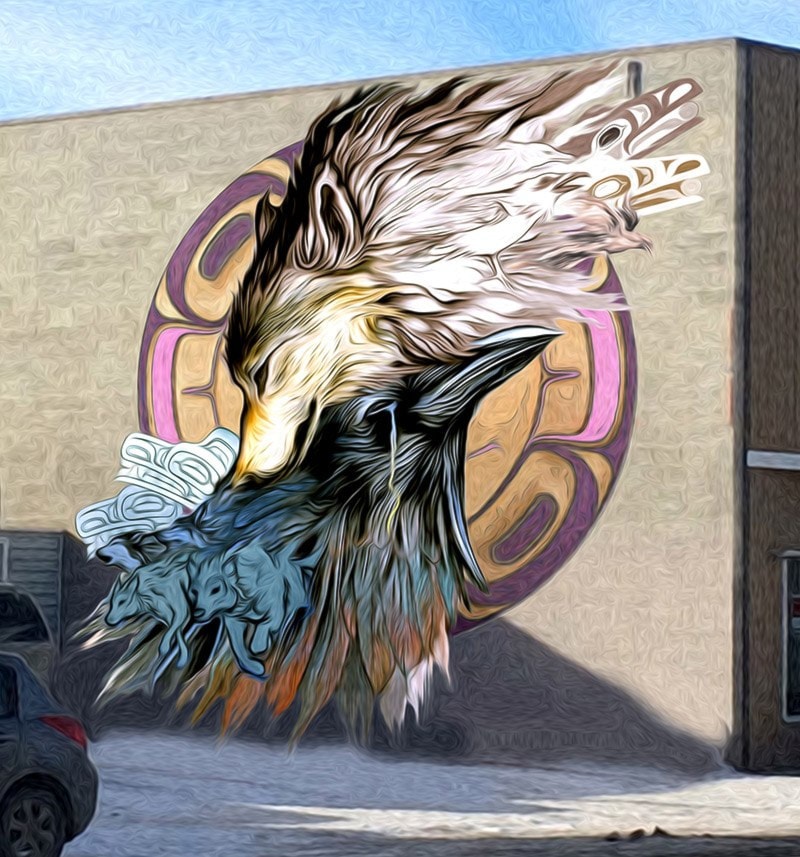Turn onto Ogilvie Street and you’re greeted by the smell of burgers and hotdogs. Kids stand around a barbecue, listening to a rap song that just dropped and discuss their latest project.
This is the scene at the Youth of Today Society every day of the week. The society, established in 1999 for high-risk youth, provides meals every day for anyone who shows up. It also offers laundry and shower facilities but its main goal is running an arts program to train youth in digital art, film and animation.
Their latest project is taking on a whole new dimension. Along with InnerVibe, Youth Of Today is hosting the Yukon Heritage Mural Art Festival in Whitehorse from May 27 to July 14.
The two-month festival involves 14 kids and five professional artists painting 11 murals around Whitehorse. Six of them will be painted downtown, including the Staples and Chamber of Mines buildings, and the other five will be in the Kwanlin Dün First Nation neighbourhood of McIntyre.
These aren’t just any kind of murals. Each of them have been specifically designed with a theme in mind. Lancelot Burton, executive director of the society, is an artist himself and was involved in the planning process.
“The mural festival is a celebration of First Nations art and culture. There is a lot going on right now with the MMIWG (inquiry) and problems of child abuse. Some of these issues are being touched on in the mural project,” he says.
The goal of the festival is to get the youth involved, bringing attention to some of the issues they face by transforming the city into an open art gallery.
“Most people don’t even know what truth and reconciliation is. Hopefully, this festival changes that and gets people to start asking questions,” Burton says.
The project brings together both Indigenous and non-Indigenous artists, each bringing their own experience and style to the murals. Rebecca Kristen Law is a graphic designer and animator who has been mentoring the kids involved with the project. Working with Indigenous artists and kids has been a learning experience for her as well.
“First Nations art is special to me because I don’t understand it and I don’t do it. So, I treasure it and honor it,” she says.
Originally from Trinidad and Tobago, Law is inspired by the island’s style of art. She shares her art with the kids and in turn they teach her about their art. For her, this sharing and learning process is an integral part of her growth as an artist. Often, the kids she mentors end up being mentors themselves.
Ali Khouda, a young artist, has been involved with several murals around the city. He says he wouldn’t be where he is right now without the guidance of Indigenous artists.
“I was trained by Tlingit artists,” he says. “They took me in like family and didn’t look at me like any other student.”
Khouda moved to Whitehorse from Iran when he was 15. He works with traditional calligraphy that has been passed on to him by his family. To him, this is reminiscent of First Nations art and the reason it drew him in.
“Art is our heritage and a way of communication our ancestors used to pass on the stories,” he says.
He says it was an honour for him when his Tlingit teachers shared their art with him. It’s what drives him to teach what he learns to the children he works with. He thinks art is a way to keep the culture alive.
“A lot of the [First Nations] culture was saved through the art. Art has been a huge part of reconciliation in terms of bringing the culture back. It’s a rope to the past that they still have their hands on and can pull it in,” he says.
Daniel Benjamin Gribben is working closely with Khouda on the murals. Gribben is from the Talhtan First Nation and has been involved with multiple projects around the city, including carving totem poles and dugout canoes. But for him, the mural festival stands out in its way of bringing people together.
“Nobody really comes and paints and carves with us in the other projects. With this one, anybody that feels like painting on the wall, they can,” he says.
Members of the public are encouraged to come join the artists and students painting around the city. Gribben believes that it’s a way to build a community and unite people. He hopes that festivals like this one help to inspire hope and change.
Law agrees that the project goes beyond just a painting on a wall.
“We’re trying to create relationships that will continue past painting a wall,” she says. “You know, you paint a wall and then what’s next? For us, it’s each other.”
Contact Sharon Nadeem at sharon.nadeem@yukon-news.com
